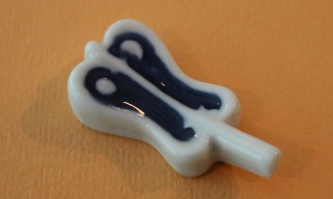There are two styles of Japanese fans:
the uchiwa, which is flat and rigid and usually round (above left), and the sensu, which has ribs and folded pleats that extend into a triangular shape (above right).
The uchiwa fan was originally developed in China. In Japan its often rounded body was decorated with attractive patterns, and sometimes used for woodblock prints, paintings, or poetry. Hokusai, among others, produced a series of woodblock prints for uchiwa, although relatively few examples survive. Today uchiwa are sometimes used for advertising or other messages. Our daughter Marisa printed the program for her summer wedding on an uchiwa.
A specialized version of the uchiwa was used as a military tool by samurai commanders during Japan’s feudal era. Known as a gumbai, this fan was made of
 two pieces of leather or metal lashed to either side of center stick. It was was used for signaling troops, but was also handy for deflecting arrows. Today gumbai are wielded by referees in sumo tournaments to signify that they are in charge.
two pieces of leather or metal lashed to either side of center stick. It was was used for signaling troops, but was also handy for deflecting arrows. Today gumbai are wielded by referees in sumo tournaments to signify that they are in charge.
The sensu folding fan is reportedly a Japanese invention. One story claims it was invented by a craftsman in the seventh century after he saw how the wings of a bat folded. If you associate this folding fan with flamenco dancers from Spain, that is because the Portuguese traders who established trading posts in Japan exported these fans to Europe, where they were subsequently adopted. Folding fans are also called iōgi in Japanese, and can also be canvases for artwork, although the folding of the fan takes a toll on these designs.
While in the West we think of fans as a feminine accessory, in Japan both men and women appreciated the relief they provided from the hot and humid summers. So both sexes often tucked a fan in the sash of their kimono. Warriors sometimes carried a folding fan known as a tessen. Made of iron, they were decorated to look like an everyday fan so they could taken into places where weapons were not allowed. These fans could be used to protect their owner as well as being deployed for attack.

Folding fans are also a dramatic accessory in Japanese Noh, Rakugo and Kabuki performances. In Kabuki, tough guys use fans to express their aggressiveness, while the men who play onnagata or female characters use them to demonstrate their grace and femininity. Geisha and maiko apprentices also use fans in their dramatic dance performances, or to coquettishly cover their faces when they’re entertaining customers.
A half open fan, like these two hashioki examples, are known as suehiro meaning “tips spread” in Japanese. They symbolize good luck, or specifically suggest growing prosperous in the same way that a fan itself expands when it opens from a closed to fully extended position.









